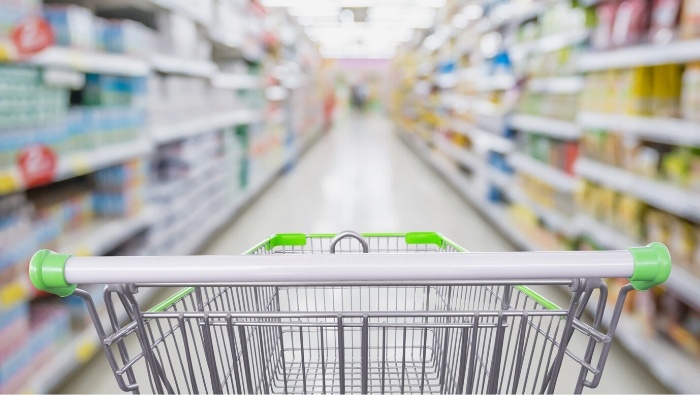6 Things To Know About Grocery Store Aisles That Will Save Money
What you save with coupons at the grocery store could be lost if you don’t have a money-saving aisle strategy. These tips can help you maneuver your store for the biggest savings.

How many times have you gone to the supermarket to buy groceries? Surely it’s too many to count.
The fact that most people tend to go to the grocery store once or twice a week makes grocery shopping quite the routine, which can make it easy to fall into a habit of doing the same thing over and over again. First, we carefully scan through the supermarket ads making a list of the best prices that week. Then we go through our coupons to see how we can save even more money off our weekly grocery bill.
Now you can save even more money by learning a few shopping aisle basics.
Shopping Aisle Basics
Have you ever really thought about the layout of your grocery store? The majority of processed and ready-to-eat foods tend to be located in the inner aisles. Why? Because these types of food items are prepackaged, means they’re able to stay on the shelves for months at a time.
The majority of fresh food options like fruits and vegetables, dairy products, meat, and seafood are all located in the outer aisles (perimeter). This makes it a good idea to start shopping in the outer aisles, mainly because fresh is better for your health. But fresh can also cost more, so what to do?
Look for fruits and vegetables that are priced to go before they go bad. Of course, you’ll have to eat them soon, which is easy enough when it comes to fresh food. This goes for meat and dairy products, too. If you don’t have an immediate use for them, simply freeze them for future use.
The following are six grocery shopping aisle basics that will help you save both time and money!
Sign Up for Savings
Subscribe to get money-saving content by email that can help you stretch your dollars further.
Twice each week, you'll receive articles and tips that can help you free up and keep more of your hard-earned money, even on the tightest of budgets.
We respect your privacy. Unsubscribe at any time.
1. Categorize your shopping list by aisle.
Avoiding aisles that aren’t on your shopping list will save you money. You may spend up to a whopping 20% more buying unplanned items if you don’t.
Although most shoppers tend to categorize their shopping list by grouping like food items together, which makes sense, once you start categorizing your shopping list by aisle you’ll soon see that you’ll be saving both money and time. If your grocer has an app, see if it has a “list” feature that will order your shopping list by aisles for you, saving you even more time.
2. Wear headphones.
How in the world can wearing headphones help save you money?
Think about the music you hear when you’re grocery shopping. It’s pretty slow and mellow, right? This is because the powers that be want you to walk slowly down the aisles, which means that you’re more apt to make unplanned purchases.
By wearing your headphones and choosing music with an upbeat tempo, you’ll not only get through the aisles faster, but you’ll also get a workout. Win-Win!
3. Look high and low.
The most expensive grocery items are often placed at eye level. You’ve probably noticed that eye-level grocery items tend to be made by very popular food brands.
How did they get such a prime location? They got it by paying the grocery store a lot of money. They know that shoppers are more likely to purchase food they can easily see. Therefore, remember to look closely at the higher and lower shelves for better deals the next time you visit your local grocery store.
4. Avoid the empty calorie aisle.
Don’t even pretend that you don’t know what aisle this is. Most grocery stores put empty-calorie foods like soda, potato chips, and candy in an aisle together because they go together, encouraging you to purchase more. These grocery items aren’t only high in cost, but also they don’t offer any nutritional value, making it a good idea to stay away from this aisle altogether. (Well, it’s okay to occasionally give in to our cravings, right?)
5. Check out the bulk aisle.
Does your local grocer have a bulk aisle? For those who use a particular food item a lot, shopping in the bulk aisle can add up to a lot of savings. The trick here is to make sure none of it goes to waste, so be sure to buy only how much you need.
Want to compare the price per ounce between bulk and non-bulk food items? Use the calculator on your cell to compare costs. Also, because fewer packaging materials are used, shopping in this aisle supports a healthier environment. Bonus!
6. Don’t be fooled by aisle endcaps.
Do you know those great specials they have at the end of every aisle on the aisle endcaps? Well, they may not be so special after all.
Again, companies pay a pretty penny to get their product placed in a great location, and aisle endcaps are quite the prime spot. The fact that these companies are paying a higher price for food placement means they have to pass these costs on to someone, which ends up being you, the consumer.
Reviewed June 2025
About the Author
Laura Foor is a freelance writer who specializes in writing quality articles for online publications for 6+ years. Graduating from UCB with a degree in Environmental Sciences in 2009, she also works part time as a Farmers Market manager where she focuses on healthy food education.

